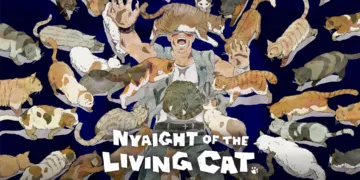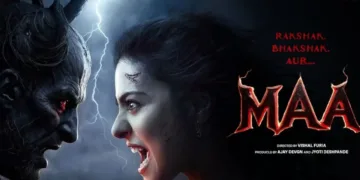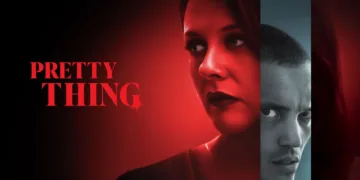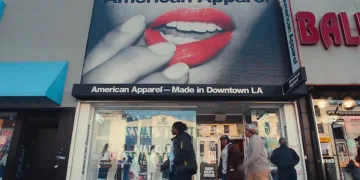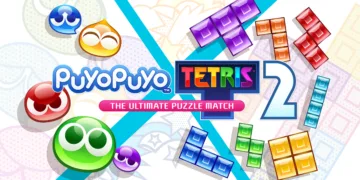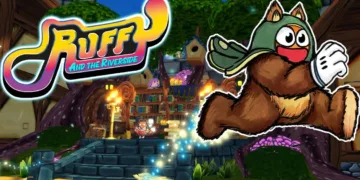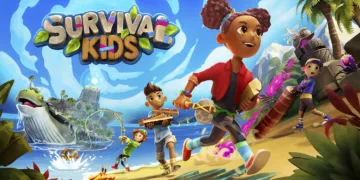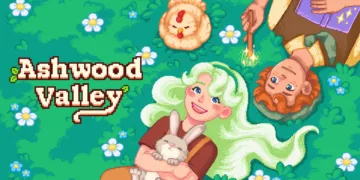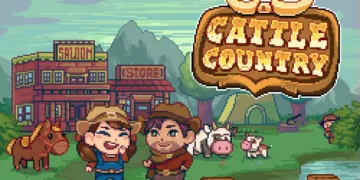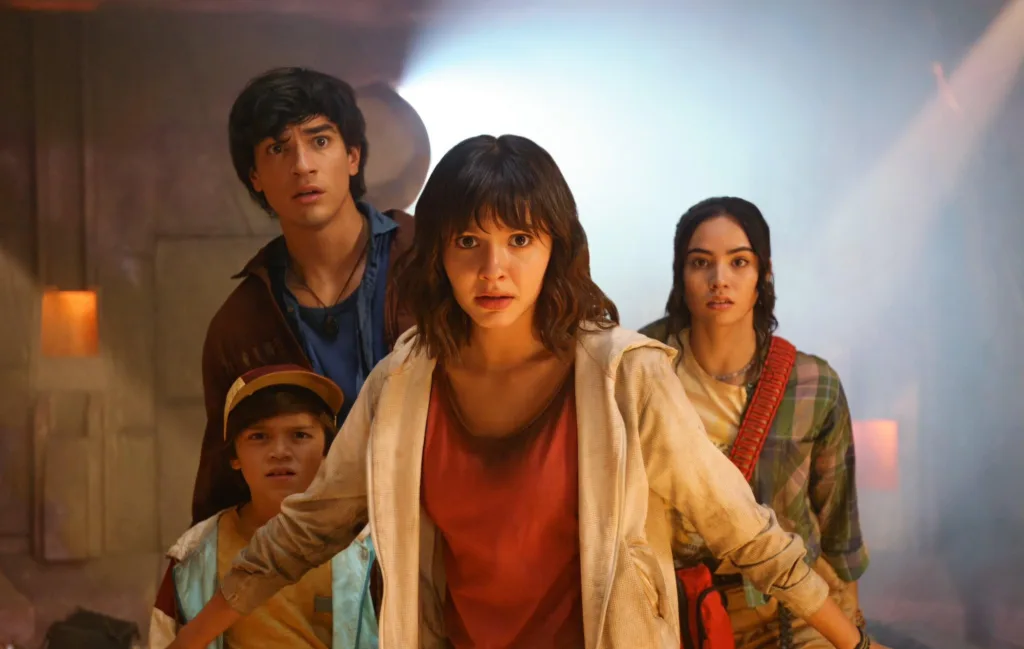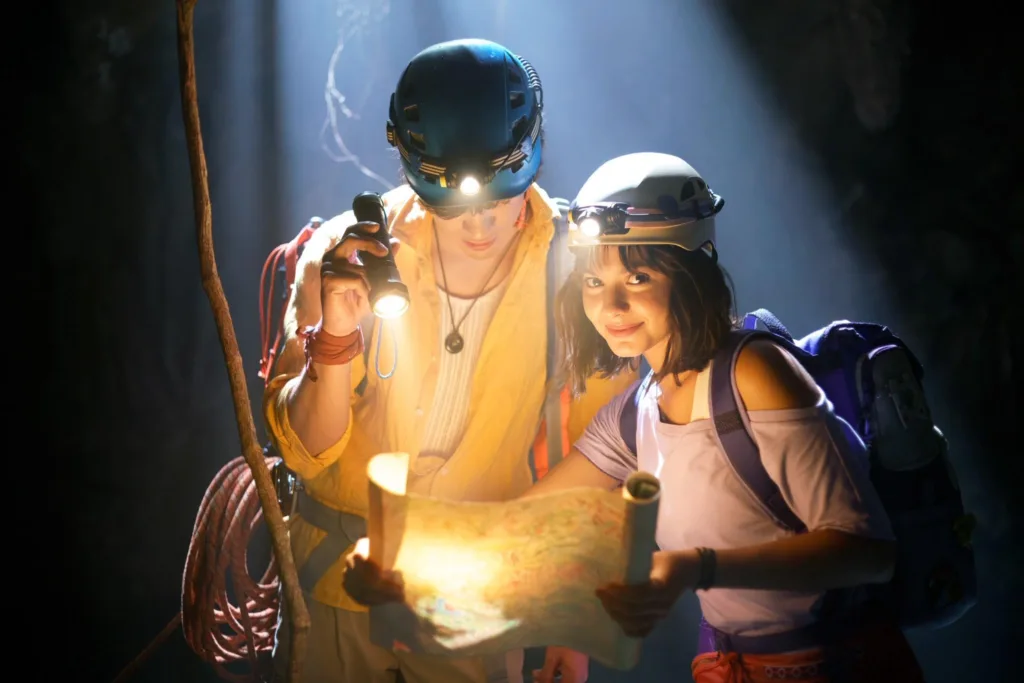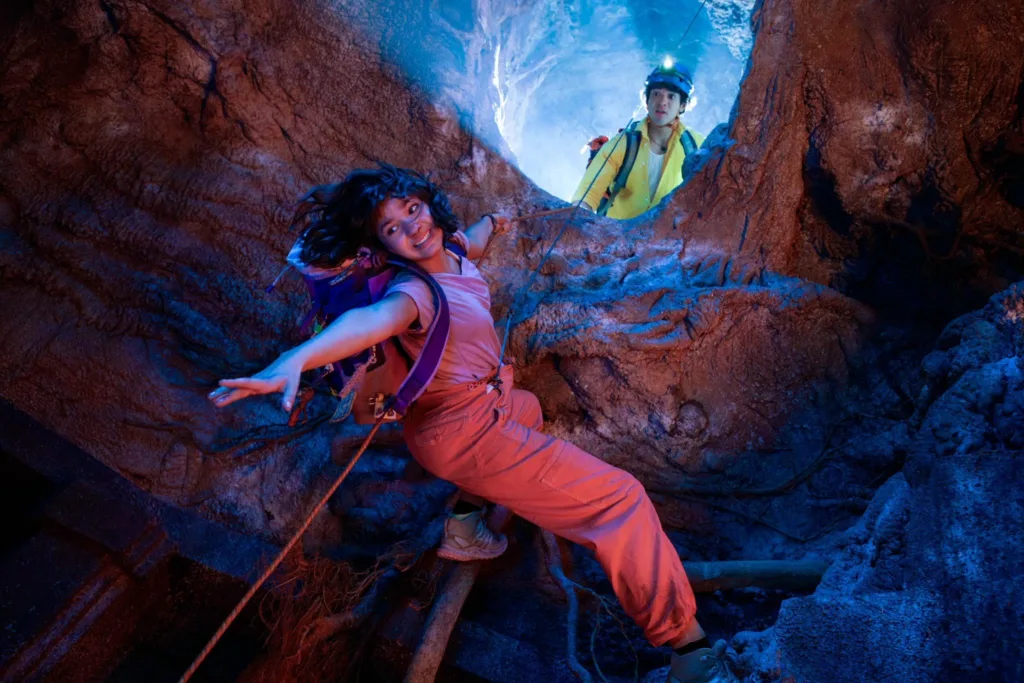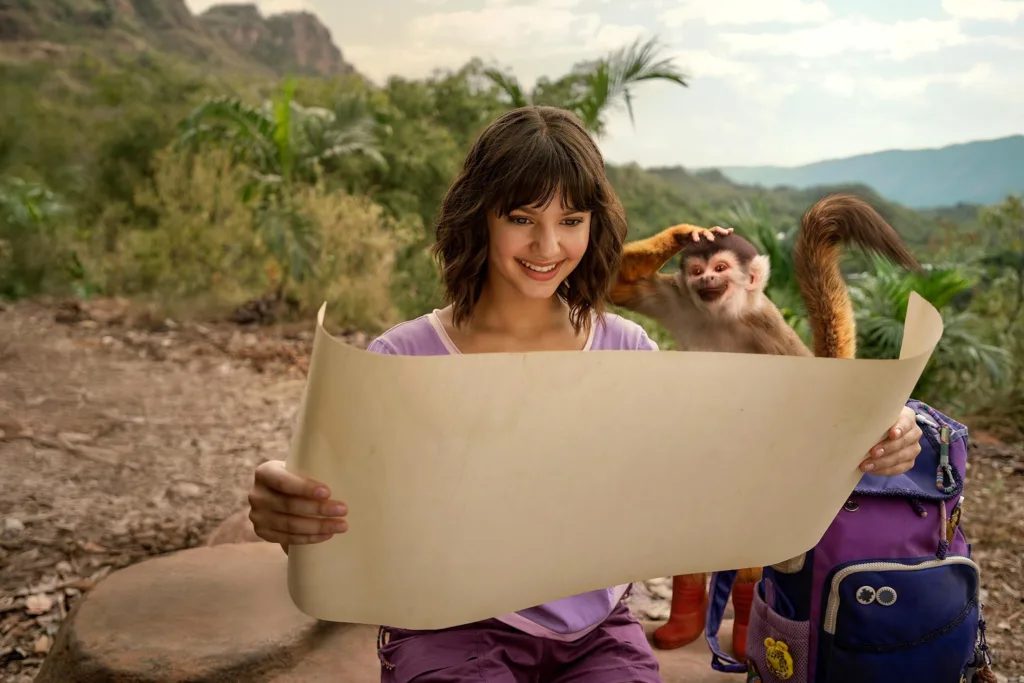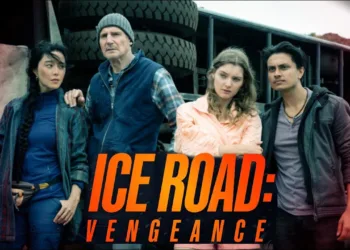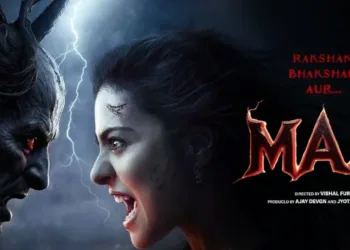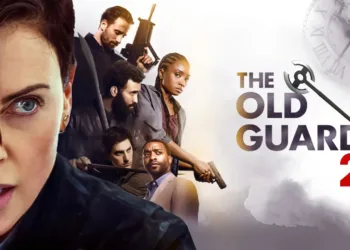There exists a peculiar melancholy in witnessing childhood’s bright certainties transformed into the flickering uncertainties of adolescence, and “Dora and the Search for Sol Dorado” dwells in this liminal space with surprising philosophical weight. This live-action reboot of the beloved animated series arrives on Paramount+ not as mere nostalgic commodity, but as an meditation on the cartographic nature of growing up—how we lose our maps, both literal and metaphorical, and must learn to navigate by darker stars.
The film follows sixteen-year-old Dora through her quest for the mythical Incan treasure Sol Dorado, but beneath this adventure narrative pulses something existentially urgent: the recognition that all our childhood heroes are, eventually, revealed to be as lost as we are. Where the 2019 theatrical predecessor traded in meta-humor and fish-out-of-water comedy, this streaming iteration returns to the animated series’ roots with a gravity that feels almost accidental—as if the filmmakers stumbled upon profundity while simply trying to honor their source material.
The central premise crystallizes around Dora’s pursuit of Sol Dorado before her former idol Camila the Crusader, who has fallen from television grace into the moral ambiguity of treasure hunting. Here lies the film’s darkest insight: that inspiration itself is corruptible, that the heroes who shape our understanding of adventure and wonder can become the very obstacles we must overcome.
Accompanied by cousin Diego, new friends Naiya and Sonny, Dora must confront not merely external dangers but the internal collapse of her mythological framework—the realization that maps, both magical and mental, are fragile constructs that abandon us precisely when we need them most.
The Architecture of Abandonment
The narrative architecture reveals itself as a meditation on loss disguised as adventure. We begin with flashbacks to young Dora learning about Sol Dorado from her grandfather—a figure who exists now only in memory, his grave a silent testament to the first great abandonment we all face. These origin sequences establish the mythological framework that will subsequently crumble: the acquisition of Map, Backpack, and the meeting with Boots the monkey feel less like magical encounters and more like the desperate construction of meaning in a world that offers none inherently.
The present-day setup at Jungle World theme park becomes a brilliant metaphor for the commercialization of wonder. Here, mechanical animals lunge from synthetic brush while canned jungle sounds play through speakers—a perfect encapsulation of how authentic experience gets commodified and packaged for mass consumption. When Dora discovers that her childhood hero Camila now works in this artificial paradise, the symbolism cuts deep: even our inspirations must eventually punch a time clock.
The film’s masterstroke lies in stripping Dora of her magical map early in the adventure. This is not merely a plot device but a philosophical statement about the nature of guidance itself. The map, which once filled itself with crayon-bright directions, becomes absence—forcing Dora to confront the terrifying possibility that there is no predetermined path, that navigation requires something more difficult than following predetermined routes.
As Dora and her companions journey through dangerous Incan caves and temples, the escalating conflict with Camila’s pursuing team mirrors the internal struggle between naive optimism and experienced cynicism. The emperor’s bracelet that provides clues becomes less a magical artifact and more a symbol of how we must actively seek meaning rather than passively receive it. When Dora is separated from her friends and must continue alone, the film achieves its most profound moment: the recognition that self-discovery is, by definition, a solitary endeavor.
The pacing, compressed into ninety minutes, creates a breathless urgency that mirrors the anxiety of adolescence itself. Character development suffers under this temporal pressure, but perhaps this is intentional—a reflection of how growth often happens in rushed, incomplete fragments rather than the neat arcs we expect from storytelling.
The Performance of Becoming
Samantha Lorraine’s portrayal of Dora operates on multiple levels of authenticity. She captures the character’s infectious optimism while allowing glimpses of the void that such relentless positivity must cover. Her performance becomes a study in the psychology of denial—how we maintain our myths even as evidence accumulates against them. The way she handles both comedic and dramatic moments suggests an understanding that humor and tragedy are not opposites but different expressions of the same existential condition.
Jacob Rodriguez’s Diego embodies the film’s central tension between loyalty and self-determination. His subplot about leaving for college in New York represents the inexorable pull of individual destiny against the gravitational force of family bonds. Rodriguez navigates this with a believable weariness—not the sullen rebellion of typical teenage characters, but the genuine exhaustion of someone who loves deeply but must still choose himself.
Daniella Pineda’s Camila the Crusader delivers the film’s most psychologically complex performance. Rather than playing a cartoonish villain, she portrays a woman who has lost her compass—quite literally, as Dora observes. Pineda brings depth to Camila’s fall from grace, showing us not a sudden corruption but the gradual erosion of purpose that can transform inspiration into exploitation. Her presence serves as a warning about what Dora might become if she allows her sense of wonder to calcify into mere acquisition.
The supporting cast operates within the constraints of their archetypal roles, but even here, philosophical weight emerges. Mariana Garzón Toro’s Naiya and Acston Luca Porto’s Sonny represent different approaches to uncertainty—she with guarded experience, he with untested enthusiasm. Their limited development feels less like a flaw and more like recognition that in the economy of growing up, not everyone gets equal narrative space.
Gabriel Iglesias’s voice work as Boots creates an interesting tension. The decision to make Boots understandable only to Dora suggests something about the privacy of imagination—how our deepest connections to wonder remain essentially incommunicable, even to those closest to us.
The Technology of Discomfort
The film’s technical aspects reveal a fascinating tension between authenticity and artificiality. The photorealistic Boots creates what can only be described as an uncanny valley of childhood—neither fully real nor acceptably fantastical. This visual disconnect becomes metaphorically appropriate: the film is about the discomfort of transitioning between different modes of reality, and the CGI monkey’s unsettling presence embodies this discomfort.
Actors contort themselves into awkward positions to interact with digital elements, creating a physical manifestation of the psychological contortions required to maintain belief in childhood myths. The reduction of Swiper the fox to a realistic animal with minimal presence suggests how the dangers we once personified as colorful villains become mundane, almost invisible threats.
The production design achieves something remarkable in its practical cave and temple sets. These spaces feel genuinely dangerous—not the sanitized peril of most family entertainment, but environments that could actually cause harm. The Colombian jungle locations breathe with authentic menace, while the Jungle World theme park succeeds in its deliberate artificiality. This contrast between real and constructed spaces mirrors the film’s central concern with authentic versus manufactured experience.
Alberto Belli’s direction maintains an energetic pace that sometimes works against the film’s deeper currents. The fast-paced cutting occasionally rushes emotional beats, but this temporal compression creates its own kind of authenticity—the breathless pace of adolescence itself, where profound realizations compete with immediate dangers for attention.
The special effects surrounding Dora’s magical items—the map that fills with crayon drawings, the backpack’s infinite contents, the emperor’s bracelet’s visions—are handled with appropriate nonchalance. These elements are treated neither as miraculous nor as purely practical, but as part of the complex ecosystem of belief that sustains us through uncertainty.
The Archaeology of Meaning
The film’s engagement with Incan culture reveals layers of meaning about how we excavate significance from the past. The incorporation of genuine historical elements—the quipu knot communication system, authentic archaeological details—suggests that learning is itself a form of treasure hunting. But the film complicates this with questions about who has the right to claim cultural artifacts and under what circumstances exploration becomes exploitation.
The bilingual integration of Spanish throughout the dialogue creates a linguistic landscape that mirrors the film’s thematic concerns. Language becomes another form of navigation, another way of constructing meaning from the raw material of experience. The educational aspect feels organic rather than forced, suggesting that learning happens best when it emerges from genuine curiosity rather than imposed curriculum.
Dora’s character development revolves around learning to navigate without external guidance—a philosophical problem that extends far beyond the immediate adventure. The difference between being lost and losing one’s purpose becomes central to the film’s meditation on direction itself. When Dora tells Camila, “I may have lost my map but you lost your compass,” she articulates a distinction between temporary disorientation and existential drift.
The family dynamics depicted here—extended Hispanic family structures, the cousin relationship between Dora and Diego, the romantic subplot between Diego and Naiya—create a network of connections that both support and constrain individual growth. These relationships become laboratories for exploring how we maintain bonds while allowing for individual development.
The moral messaging operates on multiple levels. The clear distinction between right and wrong provides the framework within which more complex questions can be explored. The contrast between Dora’s selflessness and Camila’s greed establishes basic ethical coordinates, but the film’s most interesting moments occur when these certainties become complicated by circumstance.
The Limits of Wonder
The film succeeds as family entertainment while grappling with questions that extend beyond its intended demographic. Its primary appeal to families with children coexists with a nostalgic undertow that affects adult viewers differently—not just as fond remembrance, but as confrontation with the distance between childhood certainties and adult ambiguities.
The faithfulness to the animated series’ spirit creates an interesting tension with the live-action medium’s demand for physical plausibility. The integration of iconic characters and catchphrases feels authentic rather than forced, suggesting that the filmmakers understood something essential about the source material’s appeal.
The film’s strengths—Lorraine’s charming performance, the authentic adventure sequences, the cultural education and representation—work together to create something that transcends its modest ambitions. The technical issues with CGI characters and the rushed pacing affecting character development become part of the film’s thematic landscape rather than merely production limitations.
The entertainment value operates on multiple frequencies. For children, it provides genuine adventure thrills and educational content. For adults, it offers both the comfort of familiar narratives and the discomfort of recognizing how those narratives must eventually be abandoned or transformed.
Whether this reboot approach could sustain future installments remains an open question—one that the film itself seems to acknowledge. Like Dora’s journey, the franchise’s future depends on learning to navigate without predetermined maps, on finding authentic direction in an increasingly complex landscape of possibility and limitation.
The film works as a Paramount+ exclusive precisely because it operates in the intimate space between childhood and adolescence, between family viewing and individual contemplation. It succeeds in its modest goals while suggesting that those goals might be more ambitious than they initially appear—that the work of growing up is itself a form of treasure hunting, requiring courage, curiosity, and the willingness to continue exploring even when our maps fail us.
Dora and the Search for Sol Dorado is a live-action movie that premiered on July 2, 2025. The movie is available for streaming on Paramount+ and can also be watched on Nickelodeon. It follows the adventures of a teenage Dora, her cousin Diego, and their friends as they journey through the Amazon jungle to find the ancient treasure of Sol Dorado.
Full Credits
Director: Alberto Belli
Writers: JT Billings
Producers and Executive Producers: Kristin Burr, Benjamin Tappan, Carolina Arciniegas, Adam Bonnett, Chris Gifford, Valerie Walsh Valdes
Cast: Samantha Lorraine, Jacob Rodriguez, Daniella Pineda, Mariana Garzón Toro, Jacqueline Obradors, Gabriel Iglesias, María Cecilia Botero, Acston Luca Porto, Valentina Latyna
Director of Photography (Cinematographer): Federico Cantini
Editors: Evan Ahlgren
Composer: Kenny Wood
The Review
Dora and the Search for Sol Dorado
"Dora and the Search for Sol Dorado" succeeds as both nostalgic family entertainment and philosophical meditation on growing up. Despite technical limitations and rushed pacing, Samantha Lorraine's charming performance and the film's authentic exploration of lost innocence create something deeper than typical franchise fare. The live-action adaptation respects its source while grappling with existential questions about guidance, wonder, and the inevitable corruption of childhood heroes. A surprisingly thoughtful adventure that works on multiple levels.
PROS
- Samantha Lorraine's authentic, multilayered performance
- Genuine philosophical depth about growing up
- Authentic adventure sequences with real danger
- Respectful cultural representation and bilingual integration
- Successfully balances nostalgia with mature themes
CONS
- Unsettling CGI monkey creates uncanny valley effect
- Rushed 90-minute pacing limits character development
- Supporting characters underdeveloped
- Awkward actor interactions with CGI elements
























